


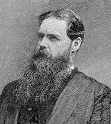








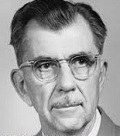



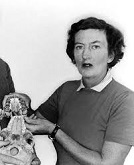

















TLW's Anthropologistscope™ (Anthropologist Historyscope) |
By T.L. Winslow (TLW), the Historyscoper™ |
© Copyright by T.L. Winslow. All Rights Reserved. |
Original Pub. Date: Feb. 20, 2016. Last Update: July 11, 2020. |

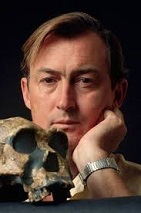


Westerners are not only known as history ignoramuses, but double dumbass history ignoramuses when it comes to Anthropology and anthropologist history. Since I'm the one-and-only Historyscoper (tm), let me quickly bring you up to speed before you dive into my Master Historyscope.
Did you ever have a burning yearning to spend your life digging for the brass monkeys? Unleash the beast :) Anthropology, the study of humanity and its alleged ancestors is divided into Social Anthropology and Cultural Anthropology, which are sometimes combined as Sociocultural Anthropology, and more often subdivided into Linguistic Anthropology and Biologial (Physical) Anthropology. In the U.S. and Canada Archeology (Archaeology) is considered a branch of Anthropology that studies Prehistory. Ethnology is a subbranch of anthropolgy analyzing the characteristics and relationships of different peoples; more subdivisions incl. Comparative Mythology and Comparative Religion. Paleontology (Palaeontology) studies all life from the Holocene Epoch (11.7K BP) back; it is combined with physical anthropology into Paleoanthropology (Palaeoanthropology). Sexology may or may not be considered part of Anthropology, but since it covers several academic fields why not, my dad once called me a mistake?
Anthropology is an invention of the Western Christian world; the Muslim World, the Inscrutable East, Africa, etc. had little to do with it until modern times. In fact, some accuse Anthropology of being an attempt to excuse white European colonialism, who the hell do you think you are Mr. Smartypants, a doctor?
Before the rise of modern Science, the Bible was considered the absolute word of God (Jehovah), containing all mankind needed to know for salvation. It claimed that the Universe was created in seven days, and that man was God's greatest creation, created in his image, with woman created as an afterthought to be his helpmate so he wouldn't be lonely and get thoughts about animals. Adam and Eve, the original human pair were perfect in every way, born sinless with the ability to talk directly with God, and placed in the Garden of Eden where perfect food-medicine grew on trees requiring minimal care, with their perfect DNA allowing them to live forever, until they blew it and sinned, and were cast out of the Garden of Eden, losing their contact with God and barred from reentering the garden by angels with swords, with their sinful DNA limiting their lifespans while they had to scratch in the dirt to eat and the women had to endure painful childbearing. Ever since supreme angel-gone-bad Satan, who tricked them into sinning, has been their god, and only a tiny number through the centuries could get out of his grip and worship the true God, which can't be seen, but must be taken on faith. Of course, by the time scientists began deciding that the Bible doesn't satisfy their curiosity, and want to be like gods by peering into the Universe's inner workings, Bible-thumpers began treating them like Satan-worshippers, and when they really went too far by applying science to humans, er, it's not over yet, check back with me after Armageddon if you can. One thing about the Bible, it claims to predict the End of Days, so it's hard to chuck in the trash can without feeling duped.
Either way, the big questions are:
1) Did mankind start out perfect and degenerate, or imperfect and evolve? 2) Is mankind the center of the Universe, or an insignificant but lucky plucker? 3) Are there such things as races, and is one superior to another, and in what way? 4) Ditto for human cultures, incl. the sexes/genders.
Either one makes pretty good sense alone, but the outrageous incompatibility between the God view and the Evolutionist view keeps everyone not quite sure if they are right no matter how long they go down their paths, although evolutionists have been embraced by Big Science and get the lion's share of the academic positions and govt. funding, just the opposite of how it started in the age when the Church ruled. Today the Marxists have deeply embedded themselves in Western academia, often trying to hide while pushing the leftist Political Correctness mindset to get what they want, with Anthropology being one of their main intellectual strongholds with its assertion of the equality of all races and cultures, forever trying to demolish all traces of the old white Christian Order of Europe and all it stood for, esp. the supposed natural order of aristocracy and white Christian male supremacy, while not really standing for anything of its own except that non-WASPs are more equal than WASPs, settle down, get married, that'll be the day. While PC labels like Racist and Sexism are usually right-on, political correctness often goes too far, using the term Islamophobia in a misguided attempt to equate Muslims with members of a race, when they're just adherents of an ideology that has a long history of intolerance and supremacy and violence, with their tolerance soon turning into appeasement, threatening to destroy everything Western liberals have fought for.

Austrian-born Jewish-Am. Marxist anthropologist Eric Robert Wolf (1923-96) is often cited for the soundbyte: "Anthopology is the most scientific of the humanities, and the most humanistic of the social sciences."

In 1542 Spanish explorer Alvar Nunez (Álvar Núñez) Cabeza de Vaca (Sp. "cow head") (1490-1557) pub. Naufragios (original title: "La Relacion y Comentarios"), an account of his journeys in the U.S. Southwest in 1528-36, containing detailed accounts of the tribes he encountered while acting as a trader and faith healer, making him a proto-anthropologist.
In 1593 the English term "anthropology" (Gr. "anthropos" + "logia" = humanity + study) was coined by English theologian Richard Harvey (1560-1630) in Philadelphus, or a Defence of Brutes and the Brutans History, becoming the first "ology". The History of Anthropology shows that Anthropology only became a science in the 19th cent.


In 1647 brother scientists Thomas Bartholin (1616-80) and Rasmus (Erasmus) Bartholin (1625-98) of the U. of Copenhagen define Anthropology as follows: "Anthropology, that is to say the science that treats of man, is divided ordinarily into Anatomy, which considers the body and the parts, and Psychology, which speaks of the soul."

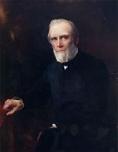
In 1650 Irish Anglican archbishop James Ussher (Usher) (1581-1656) pub. Annals of the Old Testament, Deduced from the First Origins of the World: The Chronicle of Asiatic and Egyptian Matters Together Produced from the Beginning of Historical Time up to the Beginnings of Maccabees (Annales Veteris Testamenti, a Prima Mundi Origine Deductim, una cum rerum Asiaticarum et Aegyptiacarum chronico, a temporis historici principio usque ad Maccabaicorum initia producto), a 1.6K-page Latin tome that uses the Bible to date the creation of the world to nightfall (6:00 p.m.) Sunday, October 22, 4004 B.C., which jives with the Bible verse "One day is with the Lord as a thousand years, and a thousand years as one day" (2 Peter 3:8), meaning that Jehovah gave the Earth 6K years and it's running out fast; he dates the birth of Christ to 4 B.C.E.; it is later used in annotated eds. of the King James Bible, making it super-popular; by the late 19th cent. scientists and theologians begin to ditch it, with Am. Hebrew scholar Wiliam Henry Green (1825-1900 pub. the soundbyte in the influential article Primeval Chronology in Bibliotheca Sacra (1890): "We conclude that the Scriptures furnish no data for a chronological computation prior to the life of Abraham, and that the Mosaic records do not fix and were not intended to fix the precise date either of the Flood or of the creation of the world" - a Christian would say Sunday not Saturday or Friday?
On Apr. 24, 1684 French physician-traveller Francois Bernier (1620-88) anon. pub. New Division of the Earth by the Different Species or Races of Man that Inhabit It (Nouvelle division de la terre par les différentes espèces ou races l'habitant) in the Journal des Savants, becoming the first work dividing humanity into races distinguished by skin color, with white Euros at the top (curiously lumped with people from India, the Middle East, SE Asia, and America, excusing the Egyptians and Indians because although they "are very black, or rather copper-colured, that colour is only an accident in them, and comes because they are constantly exposed to the sun"), followed by sub-Saharan Africans ("small, thin, dry, ugly, quick in running, passionately fond of carrion which they eat quite raw"), E Asians, and Sami (Lapps) ("a face that I don't know how to describe, except that it's long, truly awful, and seems reminiscent of a bear's face"), becoming the forerunner of scientific racism.
In 1706 English lexicographer John Kersey the Younger pub. a rev. ed. of The New World of English Words, which incl. the definition "Anthropology, a Discourse or Description of Man, or of a Man's Body."

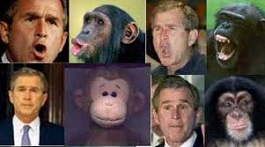
In 1749-89 French scientist ("Father of Natural History") George-Louis Leclerc, Comte de Buffon (1707-88) pub. Histoire Naturelle, générale et particulière, avec la description du Cabinet du Roy (36 vols.) (8 more vols. pub. posth.), which becomes an internat. hit, shocking Bible-thumpers with the claim that the Earth has been developing for at least 75K years via "organic particles", pointing out similarities but not the common ancestry of humans and apes while entertaining it as a hypothesis, preparing peoples' minds for the advent of Darwinism, Anthropology, etc.; too bad, he views the Caucasian race of Adam and Eve as the pinnacle, and all other races as a degenerated version caused by climate, etc. - if they only coulda seen U.S. Pres. George W. Bush?
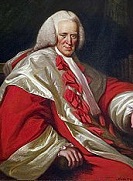
In 1758 Scottish Englightenment philosopher Henry Home, Lord Kames (1696-82) (patron of David Hume, Adam Smith, James Boswell et el.) pub. Historical Law-Tracts, first describing human social evolution in four stages, incl. hunter-gatherer, herder, farmer, and commerce (market towns), founding the fields of anthropology and sociology along with the modern study of history. In 1762 he pub. Elements of Criticism (2 vols.) (5th ed. 1772), examining the rules of lit. composition and attempting to establish a new theory based on the principles of human nature, calling the 18th cent. tradition of sentimental lit. hogtied to the notion that "the genuine rules of criticism are all of them derived from the human heart"; "Genius is allied to a warm and inflammable constitution, delicacy of taste to calmness and sedateness. Hence it is common to find genius in one who is a prety to every passion; which can scarce happen with respect to delicacy of taste. Upon a man possessed of that blessing, the moral duties, not less than the fine arts, making a deep impression, counterbalance every irregular desire; at the same time, a temper calm and sedate is not easily moved, even by a strong temptation." In 1774 he pub. Sketches of the History of Man (3 vols.) (2nd ed. 1788), which advocates polygenism, claiming that the environment can't account for racial differences, therefore the races must have been created by God in separate regions. In 1781 he pub. Loose Thoughts on Education, which plays a significant role in developing the subject of English as a discipline in Scottish univs.

On Aug. 1 and Aug. 8, 1770 Dutch anatomist-anthropologist Petrus Camper (1722-89) gives two lectures to the Amsterdam Academy (Teken-akademie), proposing the use of facial angles (prognathism) to differentiate the races, calculating the angle between lines drawn from nostril to ear and forehead to upper jawbone, with the supreme white-blonde ancient Greeks having an angle of 100-90 deg., Euros 80 deg., Orientals 70 deg., blacks 70 deg., and orangutans 42-58 deg., equating them to human beauty, making fans of Etienne Geoffroy Saint-Hilaire and Paul Broca and helping feed scientific racism.

As white Americans fight to create a new homeland for their "race" on stolen Amerindian land, a German scientist lays the theoretical basis for the original sin of white supremacy so that white will always be right theoretically no matter how the facts look? In 1776 German biologist Johann Friedrich Blumenbach (1752-1840) pub. De Generis Humani Varietate Nativa Liber (On the Natural Varieties of Humanity), which lays the foundation for the science of anthropology; taking it as given that only God can create them, he defines the four "races" of mankind as Caucasian, Mongolian, American Indian, and Ethiopian (African); in 1795 he adds Malayan; of course the punch line is that white is right and black is bad - and for the in-between colors, welcome to Progressive.com, Manwich, Manwich, we adore thee?


In 1781 Am. big brain Thomas Jefferson (1743-1826) writes Notes on the State of Virginia, his only full-length book pub. during his lifetime, pub. anon. in Paris in 1785, becoming the most important Am. book pub. before 1800?; praises Va. for its natural resources economy, as well as its ideal society, which incl. constitutional govt. with checks and balances, individual liberty, and separation of church and state; espouses his view on the races, slavery, and miscegenation, claiming that whites must be supreme and cannot live together with blacks in a free society, calling for science to prove the obvious inferiority "in the endowments both of body and mind" of blacks, speculating that blackness might come from "the color of the blood"; "They seem to require less sleep. A black, after hard labor through the day, will be induced by the slightest amusements to sit up till midnight, or later, though knowing he must be out with the first dawn of the morning. They are at least as brave, and more adventuresome. But this may perhaps proceed from a want of forethought, which prevents their seeing a danger till it be present. When present, they do not go through it with more coolness or steadiness than the whites. They are more ardent after their female: but love seems with them to be more an eager desire, than a tender delicate mixture of sentiment and sensation. Their griefs are transient. Those numberless afflictions, which render it doubtful whether heaven has given life to us in mercy or in wrath, are less felt, and sooner forgotten with them. In general, their existence appears to participate more of sensation than reflection... Comparing them by their faculties of memory, reason, and imagination, it appears to me, that in memory they are equal to the whites; in reason much inferior, as I think one [black] could scarcely be found capable of tracing and comprehending the investigations of Euclid; and that in imagination they are dull, tasteless, and anomalous... I advance it therefore as a suspicion only, that the blacks, whether originally a distinct race, or made distinct by time and circumstances, are inferior to the whites in the endowments both of body and mind." On Aug. 30, 1791 after finding out about self-educated free black almanac maker Benjamin Banneker (1731-1806), who could do math and knew astronomy, Jefferson writes a letter him, expressing his delight in being proved wrong about their supposed incurable inferiority, with the soundbyte: "No body wishes more than I do to see such proofs as you exhibit, that nature has given to our black brethren, talents equal to those of the other colors of men, & that the appearance of a want of them is owing merely to the degraded condition of their existence both in Africa & America. I can add with truth that no body wishes more ardently to see a good system commenced for raising the condition both of their body & mind to what it ought to be, as fast as the imbecility of their present existence, and other circumstance which cannot be neglected, will admit."

In Apr. 1796 Montbellard-born French naturalist ("Founding Father of Vertebrate Paleontology") Georges (Jean Leopold Nicolas Frederic) (Jean Léopold Nicolas Frédéric), Baron Cuvier (1769-1832) gives the lecture Mémoires sur les espèces d'éléphants vivants et fossiles at the Nat. Inst. (pub. in 1800), comparing skeletons of Indian and African elephants, and mastodons ("the Ohio animal"), which he concludes are all different species, the latter extinct; in 1806 he coins the name "mastodon"; he also describes a large skeleton found in Paraguay, which he names the Megatherium, claiming it is an extinct variety of the tree-dwelling sloth, ending the debate about whether extinction has actually happened, and founding Comparative Anatomy and Paleontology. In 1798 he pub. Tableau élémentaire de l'histoire naturelle des animaux, becoming the first attempt at systematic classification of the animal kingdom, founding modern Zoology (Comparative Anatomy), stressing how the parts of an organism are correlated to the functioning whole. In 1812 he pub. Recherches sur les Ossements Fossiles de Quadrupedes (Researches on Quadruped Fossil Bones), issuing his "rash dictum" that it is unlikely that any large animal remained undiscovered. In 1813 he pub. Essay on the Theory of the Earth; 2nd ed. 1815; 3rd ed. pub. 1817; 4th ed. pub. 1822; 5th ed. pub. 1827; advances the theory of catastrophism in geology, claiming that new species were created after periodic catastrophic floods after establishing the fact of past extinction; names the Pterodactyl and descries the aquatic Mosasauros, becoming one of the first to suggest that the Earth was once dominated by reptiles. In 1817 Cuvier pub. Le Règne Animal (The Animal Kingdom) (4 vols.), his magnum opus, a summation of his life's work on comparative anatomy, containing apparent support for evolutionary change for the extinct mammoths et al., making a fan of Charles Darwin, although Cuvier rejects the idea of evolution in favor of cyclical destruction-creation events via deluges; also makes fans of Richard Owen and Louis Agassiz. Too bad, Cuvier decides to pontificate on the human races, dividing them into Caucasian (white), Mongolian (yellow), and Ethopian (black), with the soundbytes: "The white race, with oval face, straight hair and nose, to which the civilised people of Europe belong and which appear to us the most beautiful of all, is also superior to others by its genius, courage and activity" and "The Negro race... is marked by black complexion, crisped or woolly hair, compressed cranium and a flat nose. The projection of the lower parts of the face, and the thick lips, evidently approximate it to the monkey tribe: the hordes of which it consists have always remained in the most complete state of barbarism"; of course, he believed in the historical existence of the Biblical Adam and Eve, calling them Caucasian and, explaining the other races as the survivors of the Great Flood 5K years ago, who developed in isolation.

In 1798 German philosopher Immanuel Kant (1724-1804) pub. Anthropology from a Pragmatic Point of View, based on lectures delivered in 1772-96, trying to define anthropology as a branch of philosophy, dividing it into a physiological category ("what nature makes of the human being") and a pragmatic category (what things a human "can and should make of himself").
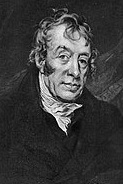
Guess who came up with the White is Right theory and drove white women to bleach their anuses, a man named White? In 1799 Manchester, England-born surgeon (pioneer in obstetrics) Charles White (1728-1813), believer in the Neoplatonic Great Chain of Being theory that "All organisms are arrange in a static chain of being, rising through small gradations from plants to animals to humans" pub. An Account of the Regular Gradation in Man, and in Different Animals and Vegetables, and from the Former to the Latter, disputing Buffon's claim that only the same species can interbreed by citing the example of hybrids incl. foxes, wolves, and jackals, regarding whites and blacks as different species that had a different origin, with blacks being more primitive thus no doubt coming from monkeys (primates), their skin pigmentation indicating inferiority (primitiveness), adding that white women are inferior to white men because they have darker pigmentation in "the areola round the nipple, the pudenda, and the verge of the anus".
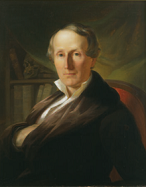
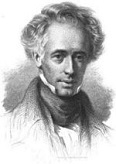
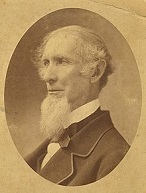
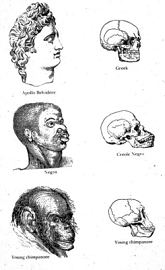
In 1839-49 Philly-born natural scientist-physician Samuel George Morton (1799-1851) along with Scottish phrenologist George Combe (1788-1858) pub. Crania Americana: or, A Comparative View of the Skulls of Various Aboriginal Nations of North and South America: To which is Prefixed an Essay on the Varieties of the Human Species (3 vols.), which claims after making his own measurements that Caucasians have the biggest brains of all races, and Negroes the smallest, proving racial superiority and inferiority, respectively; claims that the ancient Egyptians were Caucasian based on brain sizes despite frequent Negroid facial features; backs the creation story in Genesis, but claims that God created the different races via a series of multiple racial creations AKA polygenism, and that they are therefore fixed, making him "the Father of Am. Physical Anthropology", giving scientific racism its foundation and making big fans of Southern Ams. who want to keep the races separated with whitey as the massuh; too bad, Charles Darwin's 1859 "The Origin of Species" upends the debate. In 1854 S.C.-born anthropologist-surgeon Josiah Clark Nott (1804-73), English-born Am. Egyptologist George Robbins Giddon (1809-57) et al. pub. Types of Mankind, praising and supporting Samuel George Morton's work, adding the kink that negroes are not necessarily inferior to whites, just inferior at what whites do best, while superior at what they do best, with the soundbyte: "The negro achieves his greatest perfection, physical and moral, and also greatest longevity, in a state of slavery". After Morton dies, the Charleston Medical Journal pub. the soundbyte: "We of the South should consider him as our benefactor for aiding most materially in giving to the negro his true position as the inferior race."

In Nov. 1846 Swiss biologist-geologist Jean Louis Rodolphe Agassiz (1807-73) crosses over to the U.S. to take up a position as prof. of zoology and geology at Harvard U., going on to publicize the doctrine of polygenism, which claims that each species was created by God in "special provinces" and endowed with unequal attributes, denying any role for migration and adaptation, and that the conditions in which particular creatures live "are the conditions necessary to their maintenance, and what among organized beings is essential to their temporal existence must be at least one of the conditions under which they were created", rejecting monogenism as leading to impersonal atheistic materialism and regarding the Bible book of Genesis as recounting the origin of the white race only, helping found scientific racism and making him popular for at least a cent.
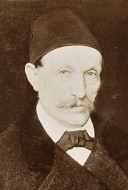
In 1846 after traveling to Egypt to study tropical diseases, German physician-anthropologist Franz Ignaz Pruner (1808-82) (AKA Pruner Bey) pub. a book in which he claims that Negro blood has a negative influence on the Egyptian moral character; in 1861 he pub. a monograph in which he claims that the main feature of Negro skeletons is prognathism, which he uses to connect them with apes, also finding their brains to be similar, and adding that Negroes have a shortened big toe, which he claims is another apelike feature - if it walks like a duck?
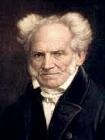

In 1851 Danzig-born German philosopher Arthur Schopenhauer (1788-1860), famous for his 1818 work "The World as Will and Representation" pub. Parerga und Paralipomena: Short Philosophical Essays (2 vols.), which contains the soundbyte that the cold Euro climate is responsible for white peoples' higher intelligence and culture: "The highest civilization and culture, apart from the ancient Hindus and Egyptians, are found exclusively among the white races; and even with many dark peoples, the ruling caste, or race, is fairer in colour than the rest, and has, therefore, evidently immigrated, for example, the Brahmins, the Inca, and the rulers of the South Sea Islands. All this is due to the fact that necessity is the mother of invention, because those tribes that emigrated early to the north, and there gradually became white, had to develop all their intellectual powers, and invent and perfect all the arts in their struggle with need, want, and misery, which, in their many forms, were brought about by the climate. This they had to do in order to make up for the parsimony of nature, and out of it all came their high civilization."

In 1853-5 French historian Joseph Arthur, Count de Gobineau (1816-82) pub. An Essay on the Inequality of the Human Races (Essai sur l'inégalité des races humaines), explaining how the Aryan Master Race (his, of course) created all culture, and how miscegenation (racemixing) ruined India, Egypt, Persia, Spain, and even has crept into France, Germany, Austria, Switzerland, everywhere, becoming the seminal doctrine of 19th cent. scientific racism, making a monkey, er, disciple of Richard Wagner - let's face it, Lexington Steele is unstoppable?

In 1855-9 French anthropologist-explorer Paul Belloni Du Chaillu (1831-1903) makes an expedition to West Africa for the Academy of Natural Sciences in Philly, in which he confirms the ancient reports of Hanno the Navigator of Carthage of the existence of gorillas; in 1861 he pub. Explorations and Adventures in Equatorial Africa, which becomes the #1 bestseller of 1861 (300K copies). In 1863-5 he makes an expedition to C Africa, discovering a race of 4'8" avg. black forest pygmies (Gr. "pygme" = distance from elbow to knuckles), (mentioned by Homer, Aristotle, and Herodotus as dwelling in Africa, fighting with cranes and attacking Hercules, who captured some of them in his lion skin and took them to King Eurystheus of Tiryns) in the Ituri Forest; in 1867 he pub. A Journey to Ashango Land.

In 1858 French anthropologist-anatomist Pierre Paul Broca (1824-80) proposes to the Societe de Biologie that physical differences between human races could be explained by different species having different origins, with the fact that they can interbreed and produce fertile offspring not proving they are of the same species but rather hybrids; when Pierre Rayer, pres. of the society proposes that he drop further discussion of the topic because Charles Darwin's work is about to come out, he agrees but founds the Societe d'Anthropologie ( Société d’Anthropologie ) de Paris in 1859 to supersede the Paris Ethnological Society (founded 1839) and take over its debates on the "appropriate relations between the black and white races". In 1859 Broca pub. On the Phenomenon of Hybridity in the Genus Homo, dividing humans into the independent racial groups Australian, Caucasian (white), Mongolian, Malayan, Ethopian (black), and American, each regarded as its own species and connected to a geographic location, taking that as disproving the monogenetic argument of common ancestry for all Homo sapiens, with physical characters not being changed by new environments, pointing to the modern Jews as having the same appearance as those portrayed in Egyptian paintings from 2,500 B.C.E., with the soundbyte: "There was even, no necessity to insist upon the difficulty, or greater geographical impossibility of the dispersion of so many races proceeding from a common origin, nor to remark that before the remote and the almost recent migrations of Europeans, each natural group of human races occupied upon our planet a region characterized by a special fauna; that no American animal was found either in Australia nor in the ancient continent, and where men of a new type were discovered, there were only found animals belonging to species, then to general, and sometimes to zoological orders, without analogues in other regions of the globe"; he adds that Darwin's monogenism attitude justifies the extinction of native pop. by colonization, with the soundbyte: "The difference of origin by no means implicates the subordination of races. It, on the contrary, implicates the idea that each race of men has originated in a determined region, as it were, as the crown of the fauna of that region; and if it were permitted to guess at the intention of nature, we might be led to suppose that she has assigned a distinct inheritance to each race, because, despite of all that has been said of the cosmopolitism of man, the inviolability of the domain of certain races is determined by their climate"; in 1866 he finally accepts monogenism. but refuses to accept evolution as the entire explanation of the origins of different species, claiming that there has to be a parallel process in operation.


The Book That Shook the World? Big year for Bible skeptics, secularists, atheistic scientists, anybody against the ancien regime, as Jehovah, the Source of Life Breathed Into Mud is challenged by Godless Evolution, Mud Coming to Life by Itself After It Bubbles Long Enough? The biggest V for the Devil since Eden? The new 95 Theses, but Darwin is smart enough not to publish it on Halloween? On Nov. 24, 1859 (Thur.) English naturalist Charles Robert Darwin (1809-82) pub. On the Origin of Species By Means of Natural Selection, Or, The Preservation of Favoured Races in the Struggle for Life; the 1st ed. sells out in 1 day; the 1872 6th ed. shortens the title to "The Origin of Species"; the decider, which causes evolutionary "survival of the fittest" theory to triumph among the intelligentsia; English Anglican minister and Cambridge U. prof. of modern history Charles Kingsley (1819-75), who received an advance copy on Nov. 18 writes that he had "long since, from watching the crossing of domesticated animals and plants, learnt to disbelieve the dogma of the permanence of the species", which Darwin adds to the next ed. of his book in a modified form: "He had gradually learned to see that it is just as noble a conception of the Deity to believe that He created a few original forms capable of self-development into other and needful forms, as to believe that He required a fresh act of creation to supply the voids caused by the action of His laws"; Darwin pub. it after spending eight years dissecting barnacles in his basement, then inexplicably switching to the Galapagos finch?; catches on first in Germany among atheists?; "If it could be demonstrated that any complex organ existed, which could not possibly have been formed by numerous, successive, slight modifications, my theory would absolutely break down"; Louis Agassiz of the U.S. opposes Darwin, preferring a theory of "Epochs of Creation", based on the absence of missing links between layers of well-formed fossil ecosystems; the phrase "I'll be a monkey's uncle" is coined by Darwin skeptics; "There is a grandeur in this view of life that, whilst this planet has gone cycling on according to the fixed law of gravity, from so simple a beginning endless forms most beautiful and most wonderful have been, and are being, evolved"; what was that about "my theory would absolutely break down" if anything is found that can't be explained by "numerous, successive, slight modifications"?; in practice Darwinism becomes a religion which denies that there is intelligent design in Nature, and therefore tries to deconstruct any evidence of it they find as they go along, yet clings to the notion of common descent, almost as if there was some original, er, accident, and ends up turning into a narrow naturalistic dogma by the end of the 20th cent., taking over U.S. and other Western educational systems with a chilling priesthood? In 1860 after failing to fit it into his Theory of Evolution, Darwin writes the immortal soundbyte: "The sight of a feather in a peacock's tail makes me sick." On Feb. 1, 1871 Darwin writes a Letter to Sir Joseph Dalton Hooker, with the soundbyte: "It is often said that all the conditions for the first production of a living organism are now present, which could ever have been present. But if (and oh! what a big if!) we could conceive in some warm little pond, with all sorts of ammonia and phosphoric salts, light, heat, electricity, &c., present, that a protein compound was chemically formed ready to undergo still more complex changes, at the present day such matter would be instantly absorbed, which would not have been the case before living creatures were found."
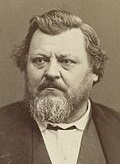
In 1864 Hesse-born German naturalist August Christoph Carl Vogt (1817-95) pub. Lectures on Man: His Place in Creation and in the History of the Earth, clinging to polygenist ideas, claiming that the white race and Negroes are separate species, with the difference being greater than two species of ape.

In 1866 Potsdam, Prussia-born German zoologist Ernst Heinrich Philipp August Haeckel (1834-1919) ("Darwin's Bulldog on the Continent") ("the Huxley of Germany"), who had a special chair in zoology created for him at the U. of Jena last year bites bigtime on Darwin's theory of evolution, and coins the word "phylogeny" for the origin and evolution of a race of animals or plants, in distinction from "ontogeny" for a single organism, and reveals the new mantra "ontogeny recapitulates phylogeny", AKA the Gastrea Theory AKA Recapitulation Theory; in 1868 he pub. an article on the phylum of (elevated to a kingdom in 1925) Monera, a pious fraud designed to push Darwinian evolution over on the German scientific community (post block ergo propter block?); in 1868 Haeckel pub. The History of Creation (Natürliche Schöpfungsgeschicht), attempting to retrace the evolution of humans, claiming that original speechless proto-humans (Urmenschen) developed separate languages that helped them transition from animal to man as separate species and races, meaning that Semitic and Indo-European languges incl. Jewish, Greco-Roman, Germanic, and Berber languages are the most developed, with the soundbyte: "Human languages probably had a multiple or polyphyletic origin. Human language as such probably developed only after the species of speechless Urmenschen or Affenmenschen (German: ape-men) had split into several species or kinds. With each of these human species, language developed on its own and independently of the others. At least this is the view of Schleicher, one of the foremost authorities on this subject... If one views the origin of the branches of language as the special and principal act of becoming human, and the species of humankind as distinguished according to their language stem, then one can say that the different species of men arose independently of one another"; no surprise, the Caucasian or white race (his) is the highest and most civilized race, and the Negro the lowest and most savage, with the soundbyte: "The Caucasian, or Mediterranean man (Homo Mediterraneus), has from time immemorial been placed at the head of all the races of men, as the most highly developed and perfect. It is generally called the Caucasian race, but as, among all the varieties of the species, the Caucasian branch is the least important, we prefer the much more suitable appellation proposed by Friedrich Müller, namely, that of Mediterranese. For the most important varieties of this species, which are moreover the most eminent actors in what is called 'Universal History', first rose to a flourishing condition on the shores of the Mediterranean... This species alone (with the exception of the Mongolian) has had an actual history; it alone has attained to that degree of civilisation which seems to raise men above the rest of nature"; he adds that Negroes have stronger and more freely movable toes than other races, which links them to the "four-handed apes"; he goes on to theorize that humans arose in India, rather than Africa like Darwin claimed, and that the missing link came from the lost continent of Lemuria, which connected Africa with Asia; "[Haeckel's] evolutionary racism; his call to the German people for racial purity and unflinching devotion to a 'just' state; his belief that harsh, inexorable laws of evolution ruled human civilization and nature alike, conferring upon favored races the right to dominate others ... all contributed to the rise of Nazism" (Stephen Jay Gould).
On Feb. 24, 1871 Charles Darwin pub. The Descent of Man, and Selection in Relation to Sex, which applies his theory of evolution to humans; "The Simidae then branched off into two great stems, the New World and the Old World monkeys; and from the latter at a remote period, Man, the wonder and glory of the universe, proceeded"; "We civilized men... do our utmost to check the process of elimination; we build asylums for the imbecile, the maimed, and the sick; we institute poor laws; and our medical men exert their utmost skill to save the life of everyone to the last moment... Thus the weak members of civilized societies propagate their kind. No one who has attended to the breeding of domestic animals will doubt that this must be highly injurious to the race of man. It is surprising how soon a want of care, or care wrongly directed, leads to the degeneration of a domestic race; but excepting in the case of man himself, hardly anyone is so ignorant as to allow his worst animals to breed"; attempts to scientifically establish white racial supremacy, with the soundbytes: "Western nations of Europe immeasurably surpass their former savage progenitors and stand at the summit of civilization"; "American aborigines, Negroes, and Europeans differ as much from each other in mind as any three races that can be named"; "At some future period, not very distant as measured by centuries, the civilised races of man will almost certainly exterminate, and replace, the savage races throughout the world. At the same time the anthropomorphous apes, as Professor Schaaffhausen has remarked, will no doubt be exterminated. The break between man and his nearest allies will then be wider, for it will intervene between man in a more civilised state, as we may hope, even than the Caucasian, and some ape as low as a baboon, instead of as now between the negro or Australian and the gorilla"; "Looking to future generations, there is no cause to fear that the social instincts will grow weaker, and we may expect that virtuous habits will grow stronger, becoming perhaps fixed by inheritance... [so that] virtue will be triumphant"; "It is the most closely allied forms... which, from having nearly the same structure, constitution, and habits, generally come into the severest competition with each other; consequently, each new variety of species, during the progress of its formation, will generally press hardest on its nearest kindred, and tend to exterminate them"; "This is the book that contains the foundation in natural history for our view" (Marx to Engels); this book is later used by Eugenicists to justify euthanasia of misfits, using soundbytes incl. "We civilized men... do our utmost to check the process of elimination; we build asylums for the imbecile, the maimed, and the sick; we institute poor laws; and our medical men exert their utmost skill to save the life of everyone to the last moment... Thus the weak members of civilized societies propagate their kind. No one who has attended to the breeding of domestic animals will doubt that this must be highly injurious to the race of man. It is surprising how soon a want of care, or care wrongly directed, leads to the degeneration of a domestic race; but excepting in the case of man himself, hardly anyone is so ignorant as to allow his worst animals to breed.... All do good service who aid toward this end."

In 1871 English anthropologist Sir Edward Burnett Tylor (1832-1917) pub. Primitive Culture: Researches into the Development of Mythology, Philosophy, Religion, Art, and Custom (2 vols.), which founds modern Cultural Anthropology, popularizing the term "animism" as the first phase of religious development, claiming that all cultures manifest a "unanimity", the result of "uniform action of uniform causes", with parallel ethnographic concepts and practices proving the existence of "law of human thought and action", preferring cultural evolution over diffusion.
In 1879 the Bureau of (American) Ethnology (BAE) is founded by the U.S. Congress to transfer archives relating to Native Ams. from the Interior Dept. to the Smithsonian Inst., with John Wesley Powell as dir. #1, who turns it into an anthropological research inst.; in 1965 it merges with the Smithsonian Dept. of Anthropology to form the Smithsonian Office of Anthropology; in 1968 their archives become the Nat. Anthropological Archives.
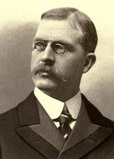
In 1884 Canadian geologist Joseph Burr Tyrrell (1858-1957) discovers bones of the Albertosaurus sarcophabus in the Badlands of Alberta, becoming the namesake of the Royal Tyrrell Museum of Palaeongoloty in Alberta.
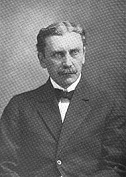
In 1885 after living for several years with the Cherokee, Richmond, Ind.-born self-taught ethnographer James Mooney (1861-1921) pub. Linguistic Families of Indian Tribes North of Mexico, with Provisional List of Principal Tribal Names and Synonyms, followed by The Sacred Formulas of the Cherokees (1891), Siouan Tribes of the East (1894), Native American Ghost Dance Songs (1894), The Ghost-Dance Religion and the Sioux Outbreak of 1890 (2 vols.) (1896), Calendar History of the Kiowa Indians (1898), Myths of the Cherokee (1902), Indian Missions North of Mexico (1907), and The Swimmer Manuscript: Cherokee Sacred Formulas and Medicinal Prescriptions (ed. Frans M. Olbrechts) (1932), founding the ethnographic study of Native Ams.

In 1890 Scottish social anthropologist Sir James George Frazer (1854-1941) pub. The Golden Bough: A Study in Magic and Religion (2 vols.); 2nd. ed. 1900 (3 vols.); 3rd ed. 1906-15 (12 vols.), bringing out similarities of ancient myths, religions, cults, and rites, and their parallels to Christianity, incl. the concept of the dying king sacrified for the good of the kingdom, pissing-off the Victorian British public by daring to incl. the story of Jesus' crucifixion and resurrection in its scope, inviting agnosticism, causing him to move the crucifixion to a s peculative appendix, and exclude the discussion of Christianity from the 1-vol. abridged ed. entirely; a gold mine for anthropologists and archeologists, turning on anthropologist Bronislaw Malinowski, philosopher Ludwig Wittgenstein, psychologist Sigmund Freud, writers Joseph Campbell, James Joyce, Ernest Hemingway, D.H. Lawrence, William Butler Yeats, T.S. Eliot, H. P. Lovecraft, Robert Graves, Ezra Pound et al.; "In this sacred grove there grew a certain tree round which at any time of the day, and probably far into the night, a grim figure might be seen to prowl. In his hand he carried a drawn sword, and he kept peering warily about him as if at every instance he expected to be set upon by an enemy. He was a priest and a murderer; and the man for whom he looked was sooner or later to murder him and hold the priesthood in his stead. Such was the rule of the sanctuary" (of Diana Nemorensis AKA Diana of the Wood in the Alban Hills SE of Rome).

In 1891 Dutch paleoanthropologist Marie Eugene Francois Thomas Dubois (1858-1940) discovers Java Man in Java, Indonesia, naming it Pithecanthropus erectus after becoming convinced that the human species originated in the tropics, becoming the first early hominid specimens to be found outside Africa or Europe, making him world famous; too bad, after fighting the scientific establishment for acceptance and gaining ground, he dies a bitter man; his specimens are later classified as Homo erectus erectus, who lived 1.8M years ago - he went ape?

In 1891 after joining the Indian Civil Service in 1873 and getting posted in Bengal, Buckinghamshire, England-born ethnographer Sir Herbert Hope Risley (1851-1911) pub. the paper The Study of Ethnology in India, founding "the racial theory of Indian civilization" (Thomas Trautmann), with the soundbyte: "By century's end had become a settled fact, that the constitutive event for Indian civilisation, the Big Bang through which it came into being, was the clash between invading, fair-skinned, civilized Sanskrit-speaking Aryans and dark-skinned, barbarous aborigines", claiming that the Rig Veda is an ancient record of it, making a fan of philologist Max Muller; in 1891 he pub. The Tribes and Castes of Bengal (4 vols.), filled with anthropometric data from his survey of Bengal, becoming a classic of scientific racism, dividing Indians into superior light-skinned Aryan and inferior dark-skinned Dravidian races using the ratio of the width of a nose to its height, and claiming that it applied throughout the Indian caste system, with the soundbytes: "The social position of a caste varies inversely as its nasal index", and "Community of race, and not, as has frequently been argued, community of function, is the real determining principle, the true causa causans, of the caste system", getting his ideas incorporated in the 1901 and 1911 Indian censuses.
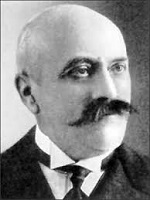
In 1899 French anthropologist ("Father of Anthroposociology") Count Georges Vacher de Lapouge (1854-1936) pub. The Aryan: His Social Role ( L'Aryen: son Rôle Social), reducing racism to dolichocephalic (Aryan) races vs. brachycephalic races, with the sliding scale: Homo europaeus (fair-haired Nordic), Homo alpinus (Auvergnat or Turkic peoples), and Homo mediterraneus (Neapoletan or Andaluz peoples), calling the Jews the only competitors of the Aryans, becoming a hit with the Nazis. In 1909 he pub. Race and Social Background: Essays in Anthroposociology (Race et Milieu Social: Essais d'Anthroposociologie).
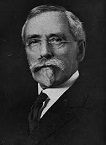
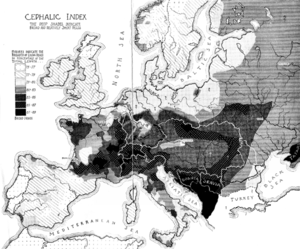
In 1899 Medford, Mass.-born economist-anthropologist William Zebina Ripley (1867-1941) pub. The Races of Man: A Sociological Study, using anthropometric cephalic index data correlated with geographic data to divide Europeans into three races, incl. Teutonic (dolichocephalic, tall, blonde, light hair, eyes, and skin), Mediterranean (dolichocephalic, short, dark hair, eyes, and skin), and Alpine (brachycephalic, stocky, intermediate hair, eyes, and skin), becoming a hit with anthropologists; too bad, he considers the Spanish an African racial type, with the soundbyte: "Africa begins beyond the Pyrenees".

In 1900 Russian-French anthropologist Joseph Denier, er, Joseph Deniker (1852-1918) pub. The Races of Man: An Outline of Anthropology and Ethnography (Races et peuples de la terre), one-upping William Z. Ripley by claiming that the peoples of Europe fall into six primary ethnic groups (not races) incl. Nordic (Germanic), Littoral (Atlanto-Mediterranean), Oriental (Eastern) (Slavic), Adriatic (Dinaric), Ibero-Insular, and Occidental (Cevneole) (Lapponoid), plus four secondary ethnic groups incl. Sub-Nordic, North-Occidental, Vistulian, and Sub-Adriatic; "In 1860, Isid. Geoffroy Saint-Hilaire admitted four principal races or 'types,' and thirteen secondary ones. In 1870, Huxley proposed five principal races or types, and fourteen secondary ones or 'modifications.' Finally, in 1878, Topinard enumerated sixteen races, and increased this number in 1885 to nineteen. In mixed classifications, based on both somatic and ethnic characters, a very much greater number of sub-divisions is found, but the reason of that is that 'ethnic groups' are included. "Putting these aside, we see in the most complete mixed classifications only four or five principal races, and twelve to eighteen secondary races. Thus Haeckel and Fr. Mueller admit four principal races (called 'tribes' by Haeckel, 'sub-divisions' by Mueller), and twelve secondary races (called 'species' and sub-divided into thirty-four 'races' by Haeckel, called 'races' and sub-divided into numerous 'peoples' by Fr. Mueller). On the other hand, De Quatrefages sub-divides his five 'trunks' into eighteen 'branches,' each containing several ethnic groups, which he distinguishes under the names of 'minor branches' and 'families.' Some years ago I proposed a classification of the human races, based solely on physical characters. Taking into account all the new data of anthropological science, I endeavoured, as do the botanists, to f orm natural groups by combining the different characters (colour of the skin, nature of the hair, stature, form of the head, of the nose, etc.), and I thus managed to separate mankind into thirteen races. Continuing the analysis further, I was able to give a detailed description of the thirty sub-divisions of these races, which I called types, and which it would have been better to call secondary races, or briefly 'races.' A mass of new material,[Pg 285] and my own researches, have compelled me since then to modify this classification - too bad, the more they try to grab the goldfish in the bowl, the more they slip through their fingers, no wonder the whole concept gets laughed off?

In 1902 the Am. Anthropological Assoc. (AAA) is founded in Arlington, Va. by 175 people after Franz Boas tried to limit it to 40 prof. anthropologists; pres. #1 (1902-12) is William John McGee (1853-1912); it takes over the journal American Anthropologist (founded 1888); in 2010 the executive board pub. the statement: "The strength of Anthropology lies in its distinctive position at the nexus of the sciences and humanities."



Just upload your catchphrases at Moron.com? In 1905 the Binet-Simon IQ Test is developed by French psychologists Alfred Binet (1857-1911) and Theodore Simon (1872-1961); too bad, to take it you have to speak French, but never fear, in 1908 East Vassalboro, Maine-born God's-gift psychologist Henry Herbert Goddard (1866-1957), dir. (1906-8) of the Vineland Training School for Feeble-Minded Girls and Boys in Vineland, N.J. trans. it into English and distributes 22K copies, introducing the term "mormon", er, "moron" and promoting not only intelligence testing to weed them out, but proposing IQ labels on May 18, 1910 (moron is actually the top of the food chain, with IQ of 51-70, i.e., mental age of 8-12, followed by imbecile at 26-50 and oh no, dumber-than-a-donut idiot at 0-25), then helping write the first U.S. law requiring special segregated education for them in public schools along with the blind and deaf; in 1912 he pub. The Kallikak Family: A Study in the Heredity of Feeble-Mindedness; now listen while I tell you a story about a man named Martin, whose Appalachian descendants get into inbreeding and become "a race of defective degenerates", causing him to call for eugenics programs incl. compulsory sterilization and segregation for the feeble-minded; in 1913 he tests IQs of 172 Euro immigrants on Ellis Island, finding that he correctly matches 80% of feeble-minded immigrants with those classed that way before they left; in 1914 he becomes the first U.S. non-moron psychologist to lend his high IQ to testify in court that being a moron should limit criminal responsibility of defendants; he also utters the unmoronly soundbyte: "Democracy means that the people rule by selecting the wisest, most intelligent and most human to tell them what to do to be happy" - what, me worry, here comes another "There are two kinds of people" messiah - not, since now morons ain't even human (you need a toupee with some brains in it, nyuk nyuk?)

In 1911 German-born Jewish-Am. anthopologist Franz Uri Boas (1858-1942) pub. The Mind of Primitive Man, shocking the racism out of U.S. anthropologists; rev. ed. pub. in 1938; "There is no fundamental difference in the ways of thinking of primitive and civilized man. A close connection between race and personality has never been established. The concept of racial type as commonly used even in scientific literature is misleading and requires a logical as well as biological definition." In 1912 Boas reports striking differences in cranial form between U.S.-born children and their Euro-born parents, showing that environment has a large effect on skull shape, shocking the fat-headed racist scientific world.
The original Planet of the Apes without claiming copyright? In 1911 Piltdown Man, the "missing link" between humans and apes is finally discovered by amateur anthropologist Charles Dawson (1864-1916) in the 50K-y.-o. 10-ft. Piltdown Quarry in Lewes (near Uckfield), East Sussex, England, and dated to the Pliocene and labeled as "Eoranthropus", dated to 500K B.C.E.; oops, after 40+ years it is proved to be a hoax (jawbone of an ape no more than 50K y.o.) in 1953 after ending up in the Farmer's Museum in Cooperstown, N.Y. in 1948; meanwhile desperate anthropologists look to save face.
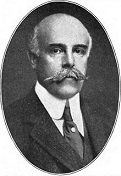
In 1916 New York City-born zoologist-conservationist (amateur anthropologist) Madison Grant (1865-1937) pub. the never-bestseller The Passing of the Great Race: Or, The Racial Basis of European History, claiming that the Nordic race is the master race, evolved in a Scandinavian climate that "must have been such as to impose a rigid elimination of defectives through the agency of hard winters and the necessity of industry and foresight in providing the year's food, clothing, and shelter during the short summer. Such demands on energy, if long continued, would produce a strong, virile, and self-contained race which would inevitably overwhelm in battle nations whose weaker elements had not been purged by the conditions of an equally severe environment", adding: that Nordics are "Homo europaeus, the white man par excellence. It is everywhere characterized by certain unique specializations, namely, wavy brown or blond hair and blue, gray or light brown eyes, fair skin, high, narrow and straight nose, which are associated with great stature, and a long skull, as well as with abundant head and body hair", and "The Nordics are, all over the world, a race of soldiers, sailors, adventurers, and explorers, but above all, of rulers, organizers, and aristocrats in sharp contrast to the essentially peasant character of the Alpines. Chivalry and knighthood, and their still surviving but greatly impaired counterparts, are peculiarly Nordic traits, and feudalism, class distinctions, and race pride among Europeans are traceable for the most part to the north"; meanwhile "The mental characteristics of the Mediterranean race are well known, and this race, while inferior in bodily stamina to both the Nordic and the Alpine, is probably the superior of both, certainly of the Alpines, in intellectual attainments. In the field of art its superiority to both the other European races is unquestioned"; "This is the race that gave the world the great civilizations of Egypt, of Crete, of Phoenicia including Carthage, of Etruria and of Mycenean Greece. It gave us, when mixed and invigorated with Nordic elements, the most splendid of all civilizations, that of ancient Hellas, and the most enduring of political organizations, the Roman State. To what extent the Mediterranean race entered into the blood and civilization of Rome, it is now difficult to say, but the traditions of the Eternal City, its love of organization, of law and military efficiency, as well as the Roman ideals of family life, loyalty, and truth, point clearly to a Nordic rather than to a Mediterranean origin"; he goes on to lament how immigration to the U.S. has been changing from Nordic to inferior types from S and E Europe, advocating their segregation into ghettos preparatory to eliminating their genes from the gene pool via sterlization, with the soundbyte: "A rigid system of selection through the elimination of those who are weak or unfit - in other words social failures - would solve the whole question in one hundred years, as well as enable us to get rid of the undesirables who crowd our jails, hospitals, and insane asylums. The individual himself can be nourished, educated and protected by the community during his lifetime, but the state through sterilization must see to it that his line stops with him, or else future generations will be cursed with an ever increasing load of misguided sentimentalism. This is a practical, merciful, and inevitable solution of the whole problem, and can be applied to an ever widening circle of social discards, beginning always with the criminal, the diseased, and the insane, and extending gradually to types which may be called weaklings rather than defectives, and perhaps ultimately to worthless race types"; despite modest sales caused by anti-German propaganda during WWI and failure to push it as a popular rather than scientific book, it becomes "the most influential tract of American scientific racism" (Stephen Jay Gould); makes a fan of Adolf Hitler, who calls it "my Bible", turning Americans away from it when the Nazi Party adopts it in the 1930s; first book to promote the White genocide (extinction) (replacement) conspiracy theory, that there is a big plot to downbreed the superior Nordic race via miscegenation, mass immigration, abortion, etc., no doubt run by the pesky Jews.

In 1920 Brookline, Mass.-born Theodore Lothrop Stoddard (1883-1950) pub. the bestseller The Rising Tide of Color Against White World-Supremacy, pushing Nordic racial theories, predicting the rise of Japan and its war with the U.S., WWII, the overthrow of colonial empires in Africa and Asia, mass immigration of non-whites to white countries, and the rise of extremist Islam; mentioned in F. Scott Fitzgerald's 1925 novel "The Great Gatsby". In 1922 he pub. The Revolt Against Civilization: The Menace of the Under Man, which introduces the term Untermensch (subhuman) and is enthusiastically adopted by the Nazis; "Usually highly prolific, often endowed with extaordinary physical vigor, and able to migrate easily, owing to modern facilities of transportation, the more backward people of the earth tend increasingly to seek the centres of civilization, attracted thither by the higher wages and easier conditions which there prevail. The influx of such lower elements into civilized societies is an unmitigated disaster. It upsets living standards, socially sterilizes the higher native stocks, and if (as usually happens in the long run) interbreeding occurs, the racial foundations of civilization are undermined, and the mongrelized population, unable to bear the burden, sinks to a lower plane." In 1927 he pub. Re-Forging America: The Story of Our Nationhood; "We want above all things to preserve America. But 'America,' as we have already seen, is not a mere geographical expression; it is a nation, whose foundations were laid over three hundred years ago by Anglo-Saxon Nordics, and whose nationhood is due almost exclusively to people of North European stock—not only the old colonists and their descendants but also many millions of North Europeans who have entered the country since colonial times and who have for the most part been thoroughly assimilated. Despite the recent influx of alien elements, therefore, the American people is still predominantly a blend of closely related North European strains, and the fabric of American life is fundamentally their creation"; "It is perfectly true that our present immigration policy does (and should) favor North Europeans over people from other parts of Europe, while it discriminates still more rigidly against the entry of non-white races. But the basic reason for this is not a theory of race superiority, but that most fundamental and most legitimate of all human instincts, self-preservation — rightly termed 'the first law of nature.'"; "The cardinal point in our immigration policy should, therefore, be to allow no further diminution of the North European element in America's racial make-up."

In 1922 after doing field work in Papua New Guinea at Mailu Island and Trobiand Islands, pioneering the practice of participant observation, Cracow-born Polish anthropologist Bronislaw Kasper Malinowski (1884-1942) pub. Argonauts of the Western Pacific: An Account of Native Enterprise and Adventure in the Archipelagoes of Melanesian New Guinea, about the Trobriand People in the Kiriwina Islands NE of Papua New Guinea, founding the science of ethnography, or study of one culture via direct contact, which is combined into multi-cultural studies by library ethnologists, who are considered second class since they're just paper-pushers?; followed by "The Sexual Life of Savages in North-Western Melanesia" (1929), and "Coral Gardens and Their Magic" (1935).

In 1924 the Taung Baby (Child), Australopithecus africanus is discovered in South Africa by Australian anthropologist Raymond Dart (1893-1988).

In 1924 Munich-born German philosopher Max Ferdinand Scheler (1874-1928) pub. Man and History, founding Philosophical Anthropology, differing with Aristotle's mind-body "rational animal" distinction by claiming that a human has a tripartite structure of body, soul, and spirit, with love and hatred not psychological emotions but intentional spiritual acts, which he calls "intentional feelings", allowing him to base his philosophical anthropology in a Christian metaphysics of the spirit, claiming that man is born with a tabula rasa vis a vis the ideas of religion, philosophy, and science, and that even if one rejects God like Nietzsche, the ubiquitousness of the concept makes it still necessary to study and deconstuct the basic concepts to build a philosophically foundational science of man, which whole idea is rejected by Martin Heidegger et al.; too bad, he dies before he can pub. his magnum opus showing how philosophical anthropology will address the totality of man while staying informed of all the sciences incl. biology, psychology, and sociology; in 1954 Karol Wojtyla (future Pope John Paul II) pub. his doctorial thesis "An Evaluation of the Possibility of Constructing a Christian Ethics on the Basis of the System of Max Scheler".
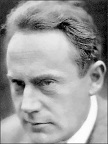
In 1926 Offenburg, Germany-born psychologist-anthropologist Ludwig Ferdinand Clauss (Clauß) (1892-1974) pub. Race and Soul (Rasse und Seele), proposing the idea that each race has a psychological "race soul" consisting of collective personality characteristics belonging to their physical race and developing over time to link with their culture; of course, the pure Nordic German race has to be "re-Nordified" by purifying them of foreign racial psychological influences to harmonize their psychic and physical racial souls, making him a hit with the Nazis; too bad. he rejects the use of the terms "superior" and "inferior" with races, with the soundbyte: "Maybe God knows the hierarchy of races, but we do not"; he follows with "The Nordic Soul" (1932) and "Race and Character" (1936); too bad, after he is discovered to be employing a Jewish research asst., the Nazi Party expels him in 1943; "One does not recognize the race of a human being based on the possession of specific characteristics, but rather in the style in which these characteristics are expressed"; "From the beginning, the psychology of race clearly teaches us that each race finds ultimate value in itself... In the final analysis it is the only factor that determines racial-spiritual values. Every race bears within itself its own value system and standard of excellence; and no race can be evaluated by the standards of any other race"; "The concept of race as formulated by the natural sciences is no longer sufficient today for grasping the field in its entirety; it proves itself insufficient as soon as we attempt to apply it in the domains of the human sciences. The treatment of the 'racial issue' in the public life suffers greatly from this evil: People recognize vaguely and instinctually that 'race' must also have some meaning in the sphere of intellectual production, but to attain a clearer view they have no other instrument at hand than the concept of race as defined by physical anthropology and biology - that is, as defined by the natural sciences. This concept is just as useless in the realm of the human sciences ... as is a telescope, a microscope, or any other instrument employed in natural-scientific research"; "The individual human being is not simply determined by racial type; rather, he or she is also shaped by other types. He or she is, for example, also a typical farmer, at typical man or typical woman, a typical female artist, et cetera. But all of these types, such as social role, are ultimately permeated by the typology of race"; "It is not possible to discern who is Nordic by examining their hair, but only by studying the attitude of their soul. Anyone who can step outside himself, freely look himself in the face and accomplish something with himself as though this self were an object - such an individual is Nordic in this one decisive trait. Based on this attitude he can shape and conquer himself. Re-Nordification does not begin with people trying to change things in others, rather it begins as the solitary achievement of the individual shaping himself. Only by following the path of solititude can one arrive at Nordic community. Re-Nordification means that every individual must reenact upon himself the act of Nordic conquest through which the German Volk first emerged on German soil"; "One can be a dissipated or criminal person in a Nordic way - we can say without qualms: one can also be a real swine in a Nordic way."

In 1927 French explorer Theodore Andre (Théodore André) Monod (1902-2000) and French biologist Vladimir Besnard (1890-1960) discover 6.4K-y.-o. (Neolithic) Asselar Man in Adrar des Ifoghas (near Essouk) in Mali, becoming the oldest known skeleton of a modern Negroid human - Cain maybe?

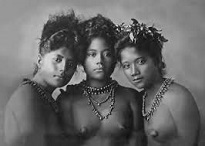
In 1928 Philly-born cultural anthropologist Margaret Mead (1901-78) (student of Franz Boas and Ruth Benedict) pub. Coming of Age in Samoa, based on her visit in 1925-7 to the land of topless babes, which claims that morals are relative to the society, becoming an anthropological bestseller; "Courtesy, modesty, good manners, conformity to definite ethical standards are universal, but what constitutes courtesy, modesty, very good manners, and definite ethical standards is not universal. It is instructive to know that standards differ in the most unexpected ways" (Franz Boas); too bad, after her death Kiwi anthropologist Derek Freeman et al. begin questioning her understanding of Samoan sexuality, causing a firestorm of controversy. In 1935 she pub. Sex and Temperament in Three Primitive Societies, which claims that females dominate males in the Chambri (Tchambuli) Lake region of the Sepik River Basin in Papua New Guinea sans problemos, meaning that masculine and feminine traits are not purely innate but are also learned, giving a boost to the feminist movement. In 1949 she rubs it in with Male and Female, based on her study of seven Pacific islands.


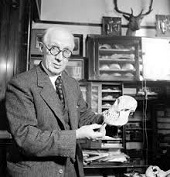
On Dec. 2, 1929 the first skull of Peking (Beijing) Man (Sinanthropus pekinensis) is discovered by Canadian anthropologist Davidson Black (1884-1934) at the Zhoukoudian (Choukoutien) Cave System 30 mi. from Beijing (discovered in 1921). German anthropologist Franz Weidenreich (1873-1948) studies it and notes numerous anatomical features in common with modern Chinese, leading to his Polycentric Evolution Model of Human Origins, that human pops. evolved independently in the Old World from Homo erectus to Homo sapiens while allowing for some gene flow, contrasting with Charles Darwin's Out of Africa Theory of Human Origins, that Homo sapiens arose as a species 270K years ago in Africa, and migrated to other continents in several waves that died out before the last wave about 70K-50K years ago via the Southern Route along the Asian coast and Australia.

In 1930 Am. anthropologist Leslie Alvin White (1900-75) is hired by the U. of Mich., going on to found its anthropology dept., rebelling against Franz Boas and proposing a model of universal cultural evolution, which views culture as driven by technology, becoming ever-more complex while consuming ever-more energy, proposing the formula "P=ET" (degree of cultural development in terms of product produced is the product of energy consumed per capita per year times the efficiency of energy utilization), with the soundbyte: "Man as an animal species, and consequently culture as a whole, is dependent upon the material, mechanical means of adjustment to the natural environment." On Jan. 1, 1959 he pub. his masterpiece The Evolution of Culture: The Development of Civilization to the Fall of Rome.

In 1931 Cambridge, Mass.-born physical anthropologist Earnest Albert Hooton (1887-1954) pub. Up from the Ape, exploring the physical differences of the negro from other races, incl. ratio of arm length to leg length in the fetus, distinguishing True Negro, African Negro, Oceanic Negro et al.; he later writes: "The negro race is phylogenetically a closer approach to primitive man than the white race", using physical anthropology to establish racial stereotypes incl. the athleticism and criminality of blacks, using mathematically rigorous race typology criteria.

In 1934 New York City-born Columbia U. prof., student of Franz Boas and collaborator-lover of Margaret Meat, er, Mead Ruth Benedict (1887-1948) pub. Patterns of Culture, which becomes a bestseller, trans. into 14 languages in many eds., becoming a std. work, making her the first woman to be recognized as prominent in a learned profession; written after visiting native Am. tribes starting in 1922, incl. the Zuni (Apollonian), Dobu (Treacherous), and Kwakiutl (Dionysian), discovering that some are matriarchial; "A culture, like an individual, is a more or less consistent pattern of thought and action"; "What really binds men together is their culture - the ideas and the standards they have in common"; "The nature of the trait will be quite different in the different areas according to the elements with which it has combined"; "If we are interested in cultural processes, the only way in which we can know the significance of the selected detail of behavior is against the background of the motives and emotions and values that are institutionalized in that culture" - oh boy, er, girl?

In 1949 after traveling to Europe in 1924 and meeting Jiddu Krishnamurti on his return journey, turning him on to the subject, White Plains, N.Y.-born Joseph John Campbell (1904-87) pub. The Hero With a Thousand Faces, original title "How to Read a Myth", which points out similarities between Western and Eastern religions, and introduces the "monomyth" (hero's journey); "Truth is one, the sages speak of it by many names."



On July 18, 1950 UNESCO releases The Race Question, written by English-born Jewish-Am. anthropologist Montague Francis Ashley-Montagu (Israel Ehrenberg) (1905-99), black Am. sociologist Edward Franklin Frazier (1894-1962) et al., questioning the validity of race as a biological concept and suggesting the substitution of "ethnic group"; revised eds. pub. in 1951, 1967, and 1978; English #1 geneticist-statistician-eugenicist (founder of modern statistical science) Sir Ronald Aylmer Fisher (1890-1962) is a notable dissenter, insisting that there are statistical racial differences, with the soundbyte: "Scientific knowledge provides a firm basis for believing that the groups of mankind differ in their innate capacity for intellectual and emotional development."

In 1952 Birmingham, England-born social anthropologist ("Father of Structural Functionalism") Alfred Reginald Radcliffe-Brown (1881-1955) posth. pub. Structure and Function in Primitive Society, becoming known as "the Father of Modern Social Anthropology" with Bronislaw Malinowski.


In 1955 Kansas City, Mo.-born anthropologist Francis (F.) Clark Howell (1925-2007) becomes a prof. at the U. of Chicago, rising to chmn. in 1966 before moving in 1970 to UCB, making field trips to Europe starting in 1953 to study the Neanderthals, moving in 1957-8 to Tanzania, then Spain in 1961-3, ending up in the Omo River region of S Ethiopa, where he pioneers postassium-argon dating methods, adding a broad spectrum of modern sciences to anthropology and becoming known as "the Father of Modern Paleoanthropology". In 1965 he pub. Early Man, which features a chart showing how easy it is for scientists like him to see back in Time by depicting an ape turning into Albert Einstein by easy jumps like a parade, which later becomes popular for dissing one's favorite enemy by inserting him in the lineup.

In 1955 in reaction to Leslie White's theory of universal cultural evolution, Washington, D.C.-born anthropologist Julian Haynes Steward (1902-72) pub. Theory of Culture Change: The Methodology of Multilinear Evolution, coining the term Cultural Ecology, for the "ways in which culture change is induced by adaptation to the environment", pissing-off some (mainly Marxist) social scientists, who don't accept any kind of environmental determinism over human actions.


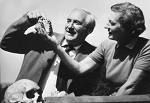
Enough to make good racists of us all? On July 17, 1959 after leading expeditions to 30 mi.-long Olduvai Gorge on the E Seregeti Plains in the Great Rift Valley 27 mi. from Laetoli, Tanganyika since Nov. 1931, Kenyan-born British archeologist-paleoanthropologist Louis Seymour Bazett Leakey (1903-72) (former British missionary, who tries to cling to Christianity and Darwinism at the same time), and his wife (since 1936) Mary Leakey (1913-96) discover the skull of 1.7M-y.-o. Nutcracker Man (Olduvai Hominid 5) (Paranthropus boisei) (Zinjanthropus in Tanganyika, which becomes the first hominin to be dated using K-Ar dating; tools found nearby are later traced to Homo habilis (announced in 1961), our "clearly subhuman ancestor" in Tanganyika, dated to -2.1M to -1.5M, which has a larger brain; the big discovery makes them famous, allowing them to finally get good funding; the Zinjanthropus cranium ends up in the Hall of Man at the Nat. Museum of Tanzania in Dar es Salaam.
In the 1960s Ecological Anthropology is founded as a response to cultural ecology.

In 1965 Time-Life Pubs. pub. Early Man, which incl. the Ape to Man Drawing (March of Man) by Russian-born Am. artist Rudolph Zallinger (1919-95), seeming to compress evolution into a single walk on a fashion model's runway, later getting widely ridiculed by creationists.
In May 1968 British anthropologist Louis S.B. Leakey announces the discovery of a crude stone hammer 12M years old, found in Ft. Ternan in Kenya along with bones of Kenyapithecus wickeri - pardon me?
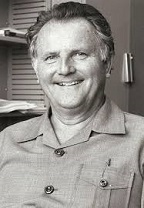
In Feb. 1969 San Diego, Calif.-born psychologist Arthur Robert Jensen (1923-2012) pub. the article How Much Can We Boost IQ and Scholastic Achievement? in the Harvard Educational Review, claiming that 80% of the variance of IQ in a pop. is the result of genetic factors, and only 20% to environmental influences, causing a firestorm of controversy along with death threats, causing him to pub. another article in 1981 with the soundbyte: "Nowhere have I 'claimed' an 'innate deficiency' of intelligence in blacks. My position on this question is clearly spelled out in my most recent book: 'The plain fact is that at present there exists no scientifically satisfactory explanation for the differences between the IQ distributions in the black and white populations. The only genuine consensus among well-informed scientists on this topic is that the cause of the difference remains an open question.'" In 1998 Jensen pub. The g Factor: The Science of Mental Ability, which claims there is a general factor of human mental ability forming a triangle of abilities, which should replace intelligence and IQ, likening it to a computer's CPU; his contention that gen. cognitive ability is an inherited trait, and that conceptual learning (synthesizing ability) occurs with greater frequency in whites than non-whites brings out the PC police; "The relationship of the g factor to a number of biological variables and its relationship to the size of the white-black differences on various cognitive tests (i.e., Spearman's hypothesis) suggests that the average white-black difference in g has a biological component. Human races are viewed not as discrete, or Platonic, categories, but rather as breeding populations that, as a result of natural selection, have come to differ statistically in the relative frequencies of many polymorphic genes. The genetic distances between various populations form a continuous variable that can be measured in terms of differences in gene frequencies. Racial populations differ in many genetic characteristics, some of which, such as brain size, have behavioral and psychometric correlates, particularly g. "

In 1972 English anthropologist Gregory Bateson (1904-80) pub. Steps to an Ecology of Mind, a contribution to Ecological Anthropology.

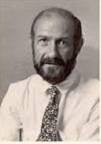
In 1972 Kenyan-born anthropologist Richard Erskine Frere Leakey (1944-) (son of Mary Leakey and Louis Leakey, who dies this year, leaving him to carry on) and South African archeologist Glynn Llywelyn Isaac (1937-85) discover a human skull in Koobi Fora Ridge on the E shore of Lake Turkana in N Kenya dated to 1.8M to 2.4M B.C.E., the oldest yet, making Leakey into a celeb.


On Nov. 24, 1974 Am. anthropologist Donald Carl Johanson (1943-) et al. discover a 3.5-ft.-tall female vegetarian tree-dwelling bipedal skeleton (AL 288-1) in 3M-y.-o. strata near the village Hadar, Ethiopia in the Awash Valley of the Afar Triangle, and name it Lucy (after the Beatles' song "Lucy in the Sky with Diamonds"), leading to the naming of a new race, er, genus, er, species, Australopithecus afarensis, dated to -3.2M - maybe it's one of the recent 100K+ famine victims?
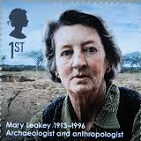
In 1975 London-born British paleoanthropologist Mary Leakey (nee Mary Douglas Nicol) (1913-96) uncovers jaws and teeth of 11 Australopithecis afarensis (direct ancestor of Homo habilis) skeletons in Laetoli, Tanzania, 25 mi. S of Olduvai Gorge, claiming that they are 3.75M-y.-o. and have human (Homo) characteristics; in 1978 she uncovers the 3.65M-y.-o. fossilized Australopithecus afarensis Laetoli Footprints in volcanic ash, claiming proof that human ancestors walked upright; it takes until 1981 to uncover all of it - you don't want to say Hail Mary around these parts?
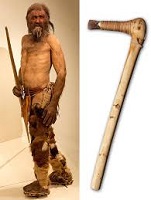
On Sept. 19, 1991 5.3K-y.-o. 5'2" 110 lb. Otzi (Ötzi) (Iceman) is found on the Tisenjoch Pass of the Similaun Glacier in the Tirolean Otzal Alps on the Italy-Austria border by German tourist Helmut Simon, complete with yew longbow, chamois quiver with 14 arrows, a copper axe, and a flint-bladed dagger in a woven sheath; he has bad teeth; his complete genome is pub. in 2012, allowing 19 people in Tyrol to identified as his descendants in 2013.

On Aug. 9, 1992 Wichita, Kan.-born Stanley Ann Dunham (1942-95), mother of future Pres. Barack Obama is awarded a doctorate in anthropology from the U. of Hawaii under the supervision of Alice Greeley Dewey (1928-), with her 1,043-page dissertation titled "Peasant Blacksmithing in Indonesia: Surviving and Thriving Against All Odds", which claims that Indonesian villagers are just as capitalistic as Westerners, but are kept down by the power elites, who steer all the capital to themselves.



In 1994 4-ft.-tall chimp-like hominid biped Ardipithecus ramidus kadabba with inch-long toe bones that live in forests in the Middle Awash River 140 mi. NE of Addis Ababa, Ethiopia (50 mi. from Hadar) is discovered by Los Angeles County, Calif.-born paleoanthropologist Tim D. White (1950-) and his Ethiopian-born UCB anthropology grad student Yohannes Haile-Selassie Ambaye (1961-), dated to -5.6M; "ardi" is Afar (a local language) for basal family ancestor, "ramid" means root, and "Kadabba" means basal family ancestor; they have a grasping opposable big toe; really should be -4.4M B.C.E.?; in 2004 Haile-Selassie, White et al. pub. an article elevating A. kadabba to a species distinct from A. ramidus.
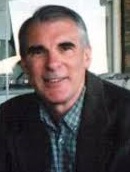
In 1995 English-born Canadian psychologist John Philippe Rushton (1943-2012) pub. Race, Evolution, and Behavior: A Life History Perspective (3rd ed. in 2000), claiming a global continuum of racial differences based on 60 variables, with Mongoloids at one end, Negroids at the other end, and Caucasoids in the middle, but closer to the Mongoloids, going on to hypothesize that the Negroids evolved 200K years ago, the Caucasoids 110K years ago, and the Mongoloids 41K years ago, with the soundbyte: "One theoretical possibility is that evolution is progressive and that some populations are more advanced than others", relating this to crime and AIDS rates, and the soundbytes: "Whites and East Asians have wider hips than Blacks... because they give birth to larger brained babies", and "Hormones that give Blacks an edge at sports makes them restless in school and prone to crime", pissing-off the PC police; "Unless one is a religious fundamentalist and believes that man was created in the image and likeness of God, it is foolish to believe that human beings are exempt from biological classification and the laws of evolution that apply to other life forms."